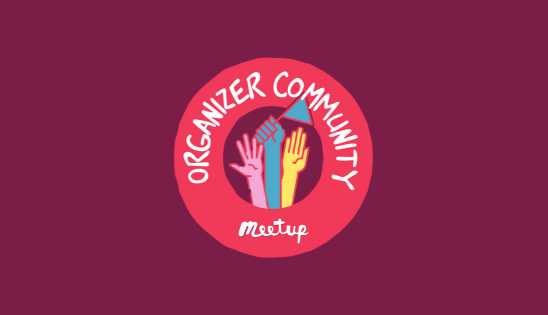The hardest part about starting a community is often figuring out what to do when you meet in real life. Rather than putting pressure on yourself, make your first event an open forum to invite members into your organizing process. Structure an exercise using our recipe below to understand why members joined your group, what they’re excited about, where works well for everyone to meet, and how they’d like the group to function. This will also be a great way for you to identify a potential leadership team and get a better idea of how your group can grow.
If an in-person event doesn’t make sense for you right now, don’t worry. Hosting your first event online is another good option for engaging with your new Meetup group. This method gives you the benefit of being able to interact with members who live far away or are out of town. While there are some general rules of thumb that apply to both IRL and digital gatherings, online events have a few different requirements to consider. Follow this simple guide and your kick-off event is sure to be a smashing success.
Where to meet
- Meet at a spacious bar, cafe, or coworking space that’s quiet enough to hear each other talk. Reserve a space or a table if you can.
- Pick a place that’s centrally located and easy to get to. Think about the parking and public transportation options.
- If you’re meeting in an office building, be sure to check with security and let your members know how they should check in.
- Get there 15-30 minutes early to check in with the host or security person and set up the space.
- If you’re meeting online, test your internet connection and make sure your computer’s sound and microphone are working before the event begins.
- Provide straightforward guidelines about muting and speaking etiquette to help the online conversation flow smoothly.
What to bring
- Stickers and markers for name tags.
- A table sign or something else to help members find your group.
- Pens, sticky notes, index cards or pieces of paper for the kick-off exercise.
- Optional of course, but pizza is always a crowd-pleaser. Don’t be afraid to ask members to chip in a few bucks to help you cover costs. On Meetup you can do this by adding a small event fee.
- When meeting online, make sure everyone knows what items they should prepare in order to be a full participant. For example, if you’re hosting a yoga event online, you’ll want everyone to have a mat ready.
Welcome everyone
Stand near the door or keep a sharp eye out for new members who are looking for your event. Consider how your new members might be feeling about meeting a group of strangers for the first time. Help everyone feel welcome by greeting them, showing them where to make a nametag, and introducing them to others standing nearby.
At an online event, the same advice for greeting applies. Say hello to every member that enters the virtual meeting space, and encourage other participants to do the same. You could set a basic structure where attendees say hello verbally, or at least in the chat, when they join. To help break the ice, ask every participant where they’re dialing in from. It’s an easy conversation starter.
Crowd-source activities
Come up with a few topics or activities that are in line with your group’s purpose. Invite members to vote or suggest additional things they’re excited about doing or learning more about. You could do this using sticky notes on poster boards, index cards and bowls, or by simply writing some ideas on paper and allowing people to add tallies or stars next to the things they’re interested in.
If you’re meeting in a quiet enough space, you may want to use the last portion of the event to get together as a group and review the votes together. If this isn’t possible, let members know that you’ll review their feedback and share an update after the event.
Your online events can also benefit from some strategic planning and brainstorming. Instead of using the same format every time, you could use tools like breakout rooms to add a different dimension to your event. Take advantage of websites like SpatialChat that allow users to create a room-like virtual space that mimics the atmosphere of an IRL gathering. Here’s a helpful list of virtual tools for improving your next online event.
Take a photo
This is an easy one to forget, but one you’ll be thankful for remembering. Do your best to take a few photos of your members chatting and having fun at the event—even better, arrange a proper group photo if it’s possible. You can use the images to update your group’s photo and use them for your future events. This will help your group grow, since new members are more likely to join a community that seems lively and active.
The same applies for online events, and it’s even easier to wrangle all your attendees together for a group photo! Learn how to take a screenshot on Mac, Windows, and Chromebook computers.
Follow up soon
Try to reach out to your members within 24 hours of the first event through Meeetup’s Event Chat. Thank them for coming, share photos, and share the results of the voting exercise. Plan your next event as soon as possible to keep up the momentum. Even if you don’t have the exact agenda planned, getting a date on the calendar will get people excited.
If you hosted an online event, send a follow-up email to get feedback about the overall experience. You can even make a simple Google Form survey and send it via email to help streamline the process. Some useful questions to ask attendees might be:
- Was it easy to participate in this event?
- Did you get to know people well?
- Was anything “missing” from this event that you’d like to see next time?
Last modified on August 30, 2023











